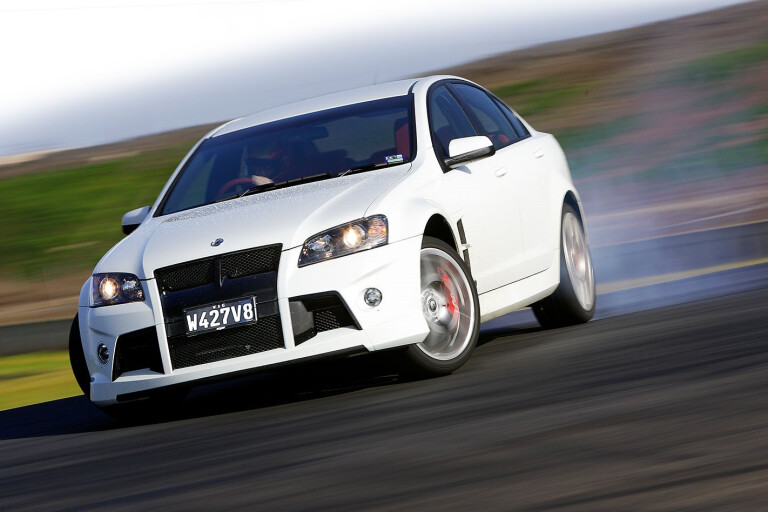
I swear Mother Nature has it in for us.
On a day when Sydney is bathed in papal-induced blue skies as the Pope preaches to the pilgrims for World Youth Day (or week), we’re sitting at Melbourne’s Calder Park staring out at horizontal rain. And we’re praying for it to stop.
This article was first published in the September 2008 issue of MOTOR.
That’s because we’re also sitting there thumbing our rosary beads and gazing at the pearly white — and gloss black — gates to Australia’s automotive heaven, one of the first W427s to roll off HSV’s Clayton production line.
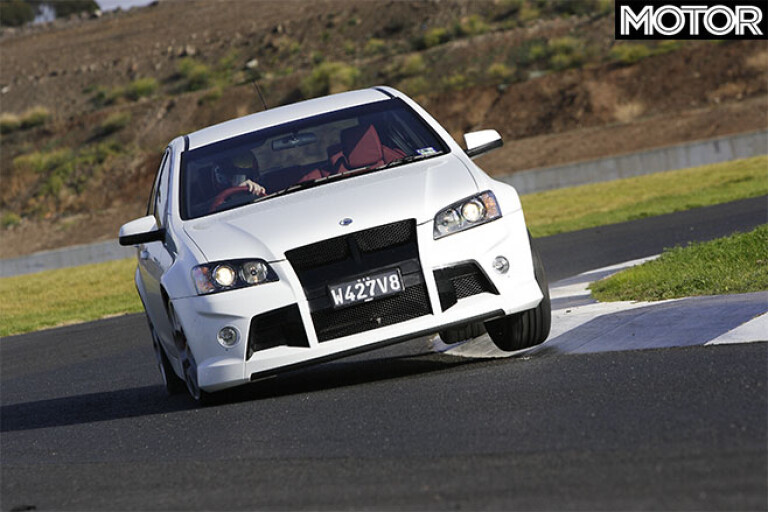
It’s like she’s bullying us and demanding that we repent our sins, in cahoots with the big guy who clearly demanded a sparkling week of winter warmth over the Harbour City, and compressed everything that’s grey and gloomy and sent it south of the border.
And it’s a Groundhog Day moment because Morley kick-started our wet-weather tête-à-tête with Mother Nature and the W427 a few months back when he slipped-and-slid around Winton in a ridgy-didge prototype.
See, the W427 and rain are like oil and water. They just don’t mix. HSV’s 20th birthday present to itself — and to the lucky few who are prepared to stump up $155,500 for one — is the pinnacle of Australia’s love affair with powerful muscle cars. And one best served dry.
It’s as big and bold as anything before it, and follows in the hallowed tyre tracks of legends such as the Monaro GTS 350 and Phase III Falcon GT HO. Give it a few decades and the W427 will, most likely, be just as collectable, rare, and expensive.
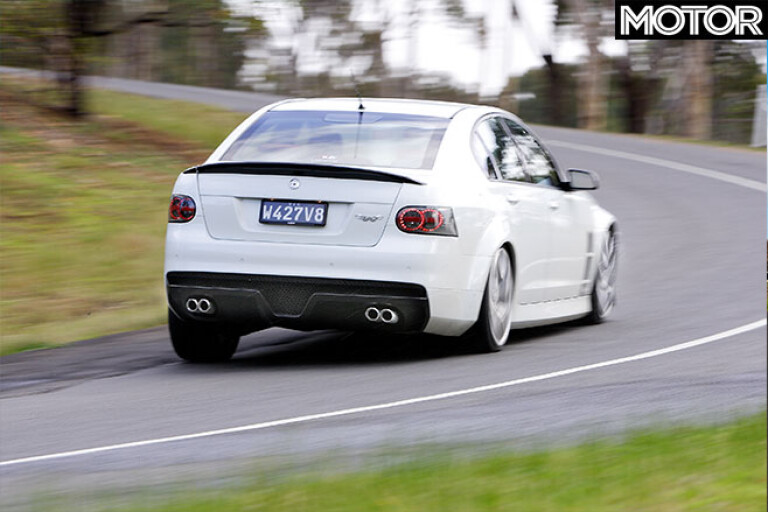
That’s precisely what HSV wants. And that, in itself, presents something of a conundrum. For all the effort HSV’s engineering team has exercised in creating this masterpiece of metal, the likelihood that most W427s aren’t going to be driven — at all — is an incredible waste.
This car is meant to be driven, and driven hard. That’s what the boffins in the engineering bunker, led by HSV chief engineer Joel Stoddart, have built it for. They haven’t scrimped on anything — at least not in the mechanical department — and they’ve created what can only be described as the greatest performance car ever conceived in this country.
The numbers alone justify that tag. It’s 7.0-litre V8 is the biggest engine to ever feature in an Australian-built sedan. It produces 375kW and 640Nm, making it the most powerful locally built production car. That much grunt also helps make it the quickest, with a claimed 0-100km/h time of 4.7sec and sub-13sec quarter-mile runs. And its final $155,500 ask trumps everything else for showroom price. The W427 has every box ticked.
So while the rain is peppering Calder’s windows at full pelt, there’s plenty of time to grill Stoddart and his troops on what’s behind the numbers.
And also why it costs so bloody much.

While the W427 is more than just a big donk, there’s no denying that the engine is the reason why the car exists. The all-alloy, pushrod-actuated LS7 is drafted straight out of the Z06 Corvette, making this the first Aussie production car to feature dry-sump lubrication, which Stoddart admits provided several head-scratching moments for his crew.
While the internals have remained untouched, including exotic stuff like titanium conrods and sodium-filled intake valves, the oil-delivery system has been engineered specifically for the W427, with a unique nine-litre reservoir that’s packaged neatly in front of the passenger-side wheel arch (where the airbox is located on a GTS).
Air is now fed directly into the guts of the LS7 through a tailor-made, over-the-radiator-style cold-air induction system, and there’s also a front-mounted 13-core engine oil cooler crammed inside the nose. Ceramic-coated, four-into-one exhaust extractors feed into a high-flow 3.0-inch-into-2.75-inch system (that’s more than half-an-inch larger in diameter than the system in the regular E-Series models).
And it also features bi-modal rear mufflers that, unlike the back-pressure-actuated system on the Falcon XR8, operate electronically according to engine speed and throttle inputs to open up and deliver a bellowing exhaust note.
Despite the dry-sump set-up, the LS7 is just two kilograms heavier than the 6.2-litre LS3 recently introduced in the E-Series, and sits 80mm further back in the engine bay for better weight distribution.
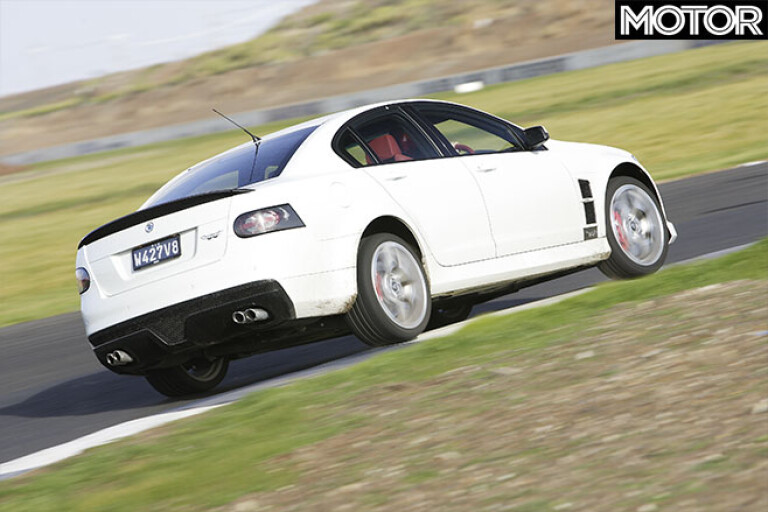
With all the hardware in place, HSV’s calibrators set out to see if they could match the ’Vette’s 377kW/637Nm outputs. While they admit the initial target was 370kW, they slowly raised the output from a “conservative” 330kW early on, through to 355kW, and finally arrived at 375kW at 6500rpm with a maximum torque figure of 640Nm at 5000rpm. Mission accomplished.
A meatier LS7 single-plate clutch has been added, which required a fair bit of reworking to the pedal assembly as well as a new actuator and master cylinder. It’s hooked up to a Tremec TR6060 six-speed manual (there won’t be an auto available) that drives a fully rebuilt high-strength limited-slip diff.
Because the entire powertrain is dropped out during the assembly process, the diff centre is shot-peened for durability and there are new bushes all round to help handle the added torque through the rear end.
While the suspension geometry is carried over from the GTS, the W427 has new linear springs that are 30-percent stiffer than standard, and the ride height has been lowered by 20mm. The Magnetic Ride Control dampers have also been re-tuned to suit the new settings.

Considering the monstrous performance the W427 is capable of, there are massive 380mm two-piece floating front rotors with six-piston calipers that offer a 50-percent increase in pad area to keep things in check. And the traction control and stability-control systems have been recalibrated to work with the bigger brakes, stiffer suspension and added grunt.
Mechanically, the W427 is improved in almost every area. It has more muscle everywhere, and HSV deserves plenty of credit for both having the balls to do it, and for doing it properly.
The jury is still out on the car’s styling, however. The new front spoiler gives the W427 awesome presence, but the lack of any exclusive parts at the rear — apart from the cool, but subtle, carbonfibre lip spoiler and machined exhaust tips — doesn’t make it look that special from behind. And that is amplified in the interior.
While the cabin is trimmed in red leather — and you’d better like it, because that’s all they offer — there’s nothing much else that conveys to the driver that you’ve shelled out $150K-plus on this car.
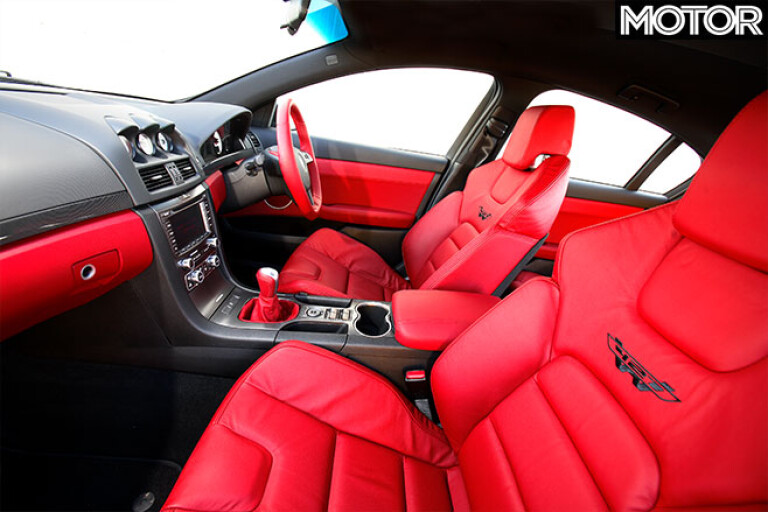
It’s all standard HSV fare. Even something as simple as adding the W427 badge to the instruments, changing the colour of the lighting or a build plaque on the glove box lid would give it some small sense of uniqueness.
And while there are only three options — sat-nav, sunroof and a rear-seat DVD system — you almost expect them to be standard, or at the very least no-cost options, in a car of this calibre. Neither is the case.

Still, it all comes back to how it drives. And, thankfully, by the time we’ve prodded and poked every last nook and cranny of the W427 and have exhaustively questioned those responsible, the clouds have parted and the howling wind has created a relatively dry line around Calder Park.
Ol‘ Mother Nature might not be so bad after all.
But that still doesn’t change the fact that Calder Park is probably better suited to ice hockey in July even when it is dry. Having not seen a V8 Supercar race for almost a decade, the track is as slippery as buggery. Almost every apex is polished like a pool ball and there are ankle-deep puddles on the exit of most corners.
It’s hardly the ideal place to crack open the fastest Aussie sedan ever built. But it could be worse — it could still be raining.
Turn the key and there’s an immediate sense of urgency about the W427 as the 7.0-litre gargles into life, its injectors firing the high-tech, hypereutectic (chemically-blended alloys in layman’s terms) pistons like cannons down the big-bore cylinders.
Give it a bootful and it spins freely with instant response, and then there’s a beautifully crafted burble of spent fuel from the exhaust on the overrun. Even standing still, this thing means business.
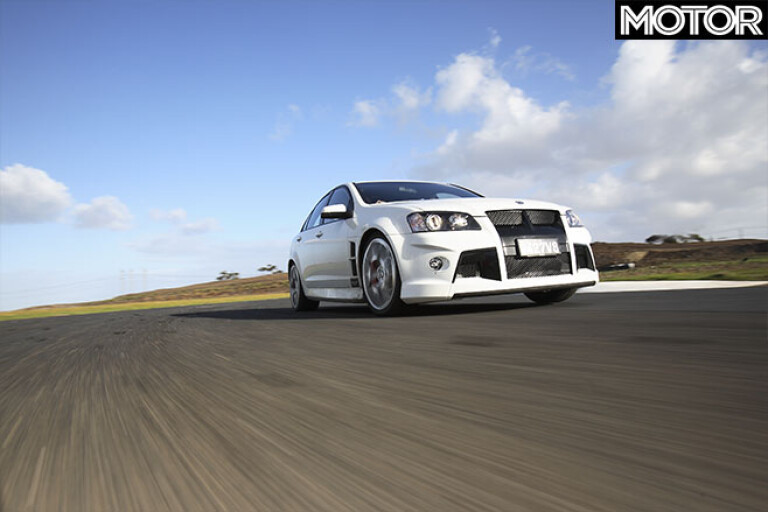
Shifting into first, there’s a noticeable improvement in the gearbox feel, with a more positive action across the synchros as the cogs engage, and one that drastically reduces the truck-like feel of the regular Clubby’s T56. The clutch engagement is better, too, with just the right amount of weight and feel.
It’s when it all gets moving that this experience really becomes special. As you sink your right foot into the firewall, the exhaust flaps open and the V8 changes its tune, transforming its tone from a guttural bellow into an orchestral wail that sings its way to the 7000rpm cut-out.
It doesn’t quite have the NASCAR soundtrack of an Audi RS4 or C63 AMG, or the techno blast of an M3 at 8000rpm, but there aren’t too many V8s that sound better.
As it hits that sweet spot above 5000rpm, where maximum torque drives the needle into the top end, there’s jumbo mumbo on tap that doesn’t fall off even as the shift alert tries to beat the engine cut-out. Actually, it feels as though the LS7’s ceiling lies well beyond the limiter.
With big power comes big speed, and luckily there are no problems retarding the W427’s pace. The brakes are phenomenally better than any other local product, with six-piston fronts and four-piston rears providing instant bite and progressive feel — as well as more-than-adequate stopping power — that is on par with any of the big-league Euro sedans HSV reckons the W427 is up against.
On the road, and at sensible speeds, it takes a couple of light stabs to get used to the immediate bite, otherwise you might find a dozy Camry driver up your freckle pretty quickly.

Despite Calder’s skatey surface, there’s noticeably more grip from the tweaked chassis when you tip it into a corner. It not only sits flatter than a standard Clubby, but has a more neutral balance between mild mid-corner understeer and power-down oversteer.
In fact, despite the stiffer springs, the W427 still has plenty of drive and traction out of corners and feels both smaller and more nimble than a GTS. But it can also be easily provoked into lurid and precisely controlled tyre-smoking drifts using the gobs of torque on offer right through the rev range. On our brief road loop, though, the W427 felt a bit choppy over broken surfaces.
Even the smallest potholes won’t be kind to your back, or the car.
While the slippery surface at Calder made it fun and easy to get the tail out, it was far from ideal for pulling the numbers HSV claims the W427 can clock down the quarter-mile. Starting on the drag strip section first soon showed why that wasn’t a good idea, as it walked off the line wheel-spinning all the way through third gear, and even stepping out on us in fourth gear at well over 150km/h. It was a big pucker moment.

Changing directions to start on an incline up the hill wasn’t going to help the end result either, but it sure was a smarter choice. It still offered little traction for a fast launch, as evidenced by the W427 taking almost one second to hit just 20km/h, or standard Clubby territory.
But once it hooked up it shot off like a rocket, blasting into triple figures in 4.9sec on its way to a quarter-mile of 12.9 at 184.9km/h. While that’s decent in any language, there’s clearly potential for a 4.6sec and mid-12 on a better day, and a better surface. We relish giving the HSV a chance to nail quicker times in better conditions some time in the future.
But given its potential, and despite its lack of ambience, the W427 is a landmark Aussie car. It scores a spot in the hall of fame even before it hits the road, and it deserves it. It has been touted as an instant collectible, but it’s such a shame that many of the 427 units HSV plans to build will be treated as investments, and probably locked away for safe keeping.
HSV has built the W427 to be driven. It wants to be driven. And, besides, the emotional rewards of pedalling the LS7 at full song on a smooth, twisty section of blacktop should far outweigh the financial rewards of staring at it in the shed for the next two decades.

COMMENTS